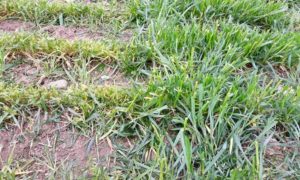Morgan N. McCulloch1 and Reagan L. Noland2
1. Agronomy Program Aide, Texas A&M AgriLife Extension Service, San Angelo, TX
2. Assistant Professor & Extension Agronomist, Texas A&M AgriLife Extension Service, San Angelo, TX
Dual-use wheat management is a common practice to optimize production of wheat as both a forage and grain crop, but Texas producers lack specific management information for this system. When managing wheat as both a forage and/or grain crop, specific grazing intensity immediately prior to jointing (first hollow stem) can influence a tradeoff between forage (or meat) and subsequent grain production. Information regarding the impacts of seeding rate and grazing intensity will enable growers to maximize forage use while still allowing a substantial grain harvest. A research project was initiated in 2018 to compare the effects of seeding rate and cutting height on grain and forage yield. This is a brief overview of project findings from the first year.
Hard red winter wheat (TAM 114) was planted at four different seeding rates of 14, 20, 28, and 34 seeds/ft2 (44, 65, 88, and 109 lbs/acre) at Millersview, TX on September 28, 2018. Before the wheat reached first hollow stem, forage was cut at four different cutting heights, 2.0, 2.5, 3.5, and 4.0 inches (Figure 1), to measure yield and nutritive value components. Wheat heads were harvested at maturity from the sampled areas to analyze grain yield and yield components under grazing, and the remainder of the plot was combine harvested to determine grain yield without grazing pressure.
Figure 1. Difference between a cutting height of 2.0 in. (left) and 4.0 in. (right)
Planting at the lowest seeding rate of 14 seeds/ft2 resulted in similar forage yield, greater RFV (Relative Feed Value), and lower NDF (Neutral Detergent Fiber), but suffered an 18% grain yield reduction (in ungrazed wheat) when compared to the three higher seeding rates. Planting at a seeding rate of 20 seeds/ft2 increased the number of seed-bearing tillers, resulting in greater ungrazed grain yield, but increasing seeding rates over 20 seeds/ft2 did not affect yield. The number of seed-bearing tillers in grazed wheat was increased by both greater seeding rates and taller cutting heights. Despite increased forage yield at lower cutting heights (Figure 2), all nutritive value components decreased due to the harvest of more fibrous structural material (stems) near the base of the plant (Table 1). The shortest cutting height resulted in higher NDF and lower RFV, while the two taller heights allowed higher CP (Crude Protein). Cutting heights at 2.0 and 2.5 also reduced the number of heads per acre further reducing the dual-use grain yield by 32-43% when compared to cutting at 4.0 inches.
Table 1. Forage nutritive value measurements relative to cutting height.
Figure 2. Forage and grain yields relative to forage cutting height in dual-use wheat.
Under the growing conditions at Millersview, TX in 2018-2019, we found that wheat managed for a dual-use purpose was optimized with a seeding rate of 20 seeds/ft2 and a final cutting/grazing height greater than 2.5 inches. This allowed for an adequate forage crop while still providing a sufficient grain harvest. Depending on producer goals, management can be adjusted to allow grazing intensity to offset losses from depressed grain markets by increasing forage utility without a major loss in grain production. Last year’s abundance of rain provided good conditions for healthy high-tillering wheat. This likely contributed to the minimal impact of seeding rate on dual-use grain or forage yield. In 2020, we might find that production is more dependent on higher seeding rates under limited rainfall conditions. In West Central Texas, wheat planted at lower seeding rates may have struggled to establish and tiller adequately due to late planting from the lack of early-season rains. Depending on specific production goals, forage utility may be minimal in order to protect grain yield potential. Having a specific end goal in mind for the 2020 growing season, grain or forage, and frequently assessing the potential of the crop, will facilitate staying ahead of management decisions and optimizing return.
